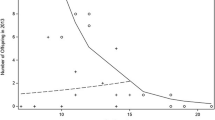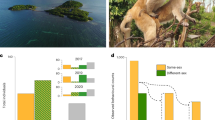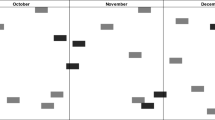Abstract
The ability to control the sex of her offspring could be of survival value to a mother1,2, and prompts questions about mechanisms of sex determination. Trivers and Willard have suggested that mothers potentially able to invest much in offspring should bear those kinds of infant that repay high levels of maternal investment most effectively2. One hypothesis concerning matrilineal primate species states that a dominant mother would leave more descendants through a daughter rather than a son if that daughter inherited her high rank3–5. On the other hand, a low ranking mother of such a species would leave more descendants through a son, for he is likely to emigrate at puberty and not necessarily inherit his mother's low rank6. Unfortunately, long-term data on primate birth sex ratios are in short supply. Here we present data collected over 20 years on a captive colony of rhesus monkeys which support the above hypothesis. High ranking rhesus monkey mothers in our captive colony7 were more likely to give birth to daughters than sons, while the remaining mothers were more likely to bear sons than daughters. Finally, we suggest a mechanism for adjusting birth sex ratios in macaques.
This is a preview of subscription content, access via your institution
Access options
Subscribe to this journal
Receive 51 print issues and online access
$199.00 per year
only $3.90 per issue
Buy this article
- Purchase on Springer Link
- Instant access to full article PDF
Prices may be subject to local taxes which are calculated during checkout
Similar content being viewed by others
References
Clutton-Brock, T. H. in Current Problems in Sociobiology (Cambridge University Press, in the press).
Trivers, R. L. & Willard, D. E. Science 179, 90–92 (1973).
Altmann, J. Baboon Mothers and Infants (Harvard University Press, Cambridge, Massachusetts, 1980).
Silk, J. B., Clark-Wheatley, C. B., Rodman, P. S. & Samuels, A. Anim. Behav. 29, 1106–1120 (1981).
Sade, D. S. in Social Communication Among Primates (ed. Altmann, S. A.) 99–114 (University of Chicago Press, 1967).
Koford, C. B. Science 141, 336–337 (1963).
Anderson, D. M. & Simpson, M. J. A. Lab. Anim. 13, 275–281 (1979).
Siegel, S. Nonparametric Statistics (McGraw-Hill, New York, 1956).
Kaplan, J. R. Am. J. phys. Anthrop. 49, 241–249 (1978).
Chapais, B. & Schulman, S. J. theor. Biol. 82, 47–89 (1980).
Lindburg, D. G. in Primate Behavior 2 (ed. Rosenblum, L. A.) 1–106 (Academic, New York, 1971).
Packer, C. Anim. Behav. 27, 1–36 (1979).
Drickamer, L. C. & Vessey, S. H. Primates 14, 359–368 (1973).
Spencer-Booth, Y. Anim. Behav. 16, 541–557 (1968).
Drickamer, L. C. Folia Primatol. 21, 61–80 (1974).
Simpson, M. J. A., Simpson, A. E., Hooley, J. & Zunz, M. Nature 290, 49–51 (1981).
Sackett, G. P., Holm, R. A., Davis, A. E. & Fahrenbruch, C. E. Symp. 5th Cong. int. Primal. Soc. (eds Kondo, S., Kawai, M., Ehara, E. & Kawamura, S.) 189–205 (Japan Science, Tokyo, 1975).
Verme, L. J. & Ozoga, J. J. J. Wildl. Mgmt 45, 710–715 (1981).
James, W. H. Lancet i, 1124–1128 (1980).
James, W. H. Br. med. J. 281, 711–712 (1980).
Hausfater, G. Contrib. Primatol. 7, 1–150 (1975).
Richards, S. M. Anim. Behav. 22, 914–930 (1974).
Author information
Authors and Affiliations
Rights and permissions
About this article
Cite this article
Simpson, M., Simpson, A. Birth sex ratios and social rank in rhesus monkey mothers. Nature 300, 440–441 (1982). https://doi.org/10.1038/300440a0
Received:
Accepted:
Issue Date:
DOI: https://doi.org/10.1038/300440a0
This article is cited by
-
Why empresses have more sons? Maternal instant social condition determines it
Behavioral Ecology and Sociobiology (2022)
-
Weaned age variation in the Virunga mountain gorillas (Gorilla beringei beringei): influential factors
Behavioral Ecology and Sociobiology (2016)
-
Factors Influencing the Reproductive Success of Female Black Howlers (Alouatta pigra)
International Journal of Primatology (2016)
-
Proximate and ultimate explanations of mammalian sex allocation in a marsupial model
Behavioral Ecology and Sociobiology (2014)
-
Male pygmy hippopotamus influence offspring sex ratio
Nature Communications (2012)
Comments
By submitting a comment you agree to abide by our Terms and Community Guidelines. If you find something abusive or that does not comply with our terms or guidelines please flag it as inappropriate.



